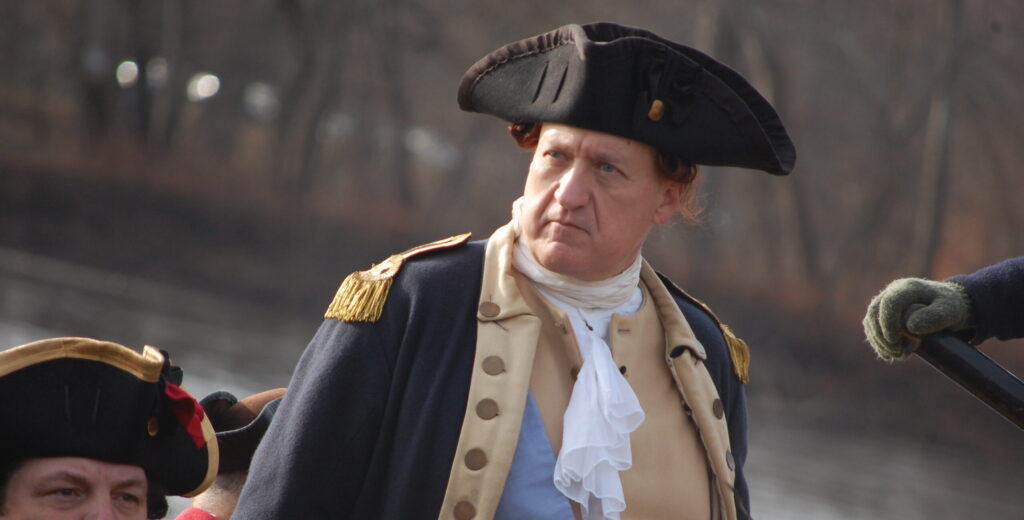
By David Price, WCHP Historical Interpreter
Not long ago I had the opportunity to read a chapter in a manuscript about the turning points of the war for independence. This particular chapter covered the “Ten Crucial Days” (TCD) from December 25, 1776 to January 3, 1777, when Washington’s army won its first three significant victories and profoundly altered the course of the conflict. The draft cited to a quote by a noted military historian referring to the Continental Army’s Christmas Night 1776 crossing, which asserted that this action was perhaps Washington’s only “really brilliant” stroke of the war.
Having spent the last nine years immersed in the TCD, I certainly appreciate any recognition of it by the historical community but would take issue with this assessment as being less than fair to Washington. While perhaps not a brilliant strategist, he did have his moments, such as these:
1. Ordering Colonel Henry Knox to retrieve nearly sixty cannon from Fort Ticonderoga in late 1775 and then placing them on Dorchester Heights outside British-occupied Boston, which forced the British to evacuate the city in March 1776 or otherwise launch a suicidal attack, was, if not “brilliant,” an awfully shrewd piece of generalship.
2. The evacuation of Washington’s army from Brooklyn Heights to Manhattan on the night of August 29-30, 1776–at night in small craft on difficult water without detection by a larger and more powerful enemy army and fleet–was one of the most skillful in military history. While not undoing Washington’s litany of errors in connection with the Battle of Long Island on August 27, it saved a substantial portion of his army.
3. The deployment of troops along the Princeton-Trenton Road on New Year’s Eve 1777 proved to be absolutely brilliant due to the leadership of Colonel Edward Hand, whose delaying action against the enemy’s march to Trenton on January 2, 1777 arguably forestalled the destruction of Washington’s army at what may have been the most pivotal military encounter of the war—the Battle of Assunpink Creek.
4. The end run by Washington’s army around General Charles Cornwallis’s left flank from Trenton to Princeton on the night of January 2-3, 1777, which extricated the rebels from perilous circumstances and led to the final victory of the TCD at Princeton, was not exactly chopped liver.
5. If sending reinforcements from his own army—including, in particular, Colonel Daniel Morgan’s riflemen–to upstate New York to support the resistance to General John Burgoyne’s Saratoga expedition in 1777 wasn’t brilliant, it sure as heck was very astute. Author Kevin Weddle makes a point of this in The Compleat Victory: Saratoga and the American Revolution.
6. Naming General Nathanael Greene to command the Southern Department of the Continental Army in late 1780 was more than brilliant. It was genius. Greene’s masterful Southern campaign, with the vital assistance of rebel militia, drove the British from the interior of the Carolinas and pinned them inside their coastal sanctuaries in Charleston and Savannah, which they evacuated before the end of 1782.
7. I have no hesitation in characterizing as “brilliant” the maneuvers orchestrated by Washington in the late summer of 1781 that deceived British General Henry Clinton into thinking a Franco-American assault on occupied New York City was impending and diverted his attention from the allied troop movement southward to trap Cornwallis’s army at Yorktown, Virginia. This action precluded Clinton’s timely intervention on behalf of Cornwallis and conduced to the climactic victory of the war.
8. And finally, while not of a strictly military nature, perhaps Washington’s most brilliant stroke was to order mass inoculation of the Continental Army against smallpox in 1777, a dramatic gesture that was not without controversy and arguably indispensable to preserving the integrity of his army, as well as being the first major public health initiative undertaken in America.
David is the author of a trilogy about the “Ten Crucial Days”—John Haslet’s World, The Road to Assunpink Creek, and Rescuing the Revolution. His other book, The Battle of Harlem Heights, 1776, is part of the Westholme Small Battles series. David has been awarded the National Society of the Sons of the American Revolution Bronze Good Citizenship Medal in recognition of his work as an author, speaker, and historical interpreter at WCHP and Princeton Battlefield State Park. More information about him and his work can be found at dpauthor.com.

